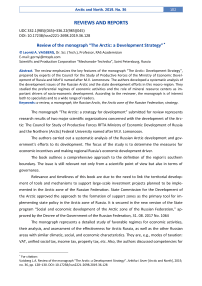Review of the monograph “The Arctic: a Development Strategy”
Автор: Leonid A. Vaisberg
Журнал: Arctic and North @arctic-and-north
Рубрика: Reviews and reports
Статья в выпуске: 36, 2019 года.
Бесплатный доступ
The review emphasizes the key features of the monograph “The Arctic: Development Strategy”, prepared by experts of the Council for the Study of Productive Forces of the Ministry of Economic Development of Russia and NArFU named after M.V. Lomonosov. The authors developed a systematic analysis of the development issues of the Russian Arctic and the state development efforts in this macro-region. They studied the preferential regimes of economic activities and the role of mineral resource centers as important drivers of socio-economic development. According to the reviewer, the monograph is of interest both to specialists and to a wide range of readers.
A review, a monograph, the Russian Arctic, the Arctic zone of the Russian Federation, strategy
Короткий адрес: https://sciup.org/148318450
IDR: 148318450 | УДК: 332.1(985)(045)+336.22(985)(045) | DOI: 10.17238/issn2221-2698.2019.36.128
Текст научной статьи Review of the monograph “The Arctic: a Development Strategy”
The monograph “The Arctic: a strategy for development” submitted for review represents research results of two major scientific organizations concerned with the development of the Arctic: The Council for Study of Productive Forces RFTA Ministry of Economic Development of Russia and the Northern (Arctic) Federal University named after M.V. Lomonosov.
The authors carried out a systematic analysis of the Russian Arctic development and government's efforts to its development. The focus of the study is to determine the measures for economic incentives and making regional Russia's economic development driver.
The book outlines a comprehensive approach to the definition of the region's southern boundary. The issue is still relevant not only from a scientific point of view but also in terms of governance.
Relevance and timeliness of this book are due to the need to link the territorial development of tools and mechanisms to support large-scale investment projects planned to be implemented in the Arctic zone of the Russian Federation. State Commission for the Development of the Arctic approved the approach to the formation of support zones as the primary tool for implementing state policy in the Arctic zone of Russia. It is secured in the new version of the State program “Social and economic development of the Arctic zone of the Russian Federation,” approved by the Decree of the Government of the Russian Federation, 31. 08. 2017 No. 1064
The monograph represents a detailed study of favorable regimes for economic activities, their analysis, and assessment of the effectiveness for Arctic Russia, as well as the other Russian areas with similar climatic, social, and economic characteristics. They are, e.g., modes of taxation: VAT, unified social tax, income tax, property tax, etc. Also, the authors discussed competencies for
∗ For citation:
residents of individual modes and management companies; they defined features of each mode (validity periods, the territory, the infrastructure, restrictions for residents, the responsibility for achieving the targets, esp. government support, etc.). The evaluation of the effectiveness in the monograph means the assessment of special economic zones and analysis of the reasons led to the unsuccessful implementation of various regimes in the Russian Arctic. The authors also attempted to evaluate the effectiveness of the territories of advancing socio-economic development.
The authors completed the analysis of the federal and regional legislation to identify measures to promote social and economic development and defining features of the management mode in every Arctic territory. The study lets the authors develop proposals on a toolbox of modes of economic activity following the management type in the territories of the Russian Arctic. It was supplemented by the justification of specifics for the application of economic modes in every area.
Besides, the authors analyzed the possibility of such regimes on the territory of the macroregion and the formation of mineral centers conceivable to be the main drivers of socio-economic development.
It should be noted, a group of authors formulated the original science-based proposals for tools to create and support the development of support areas in the Russian Arctic, incl. those planned for the creation of mineral centers. Several mechanisms that could form the basis for supporting areas were suggested. The authors considered state support mechanisms, incl. for small and medium-sized businesses and makes proposals to maintain the budgetary efficiency of the Arctic territories.
In general, obtained research results presented in the book are recommended for publication as they are significant in decision-making on the Russian state policy in the Arctic. The monograph will, no doubt, be of interest to a broader audience.


